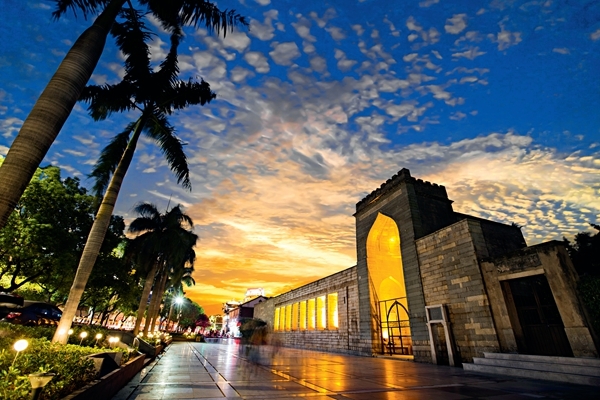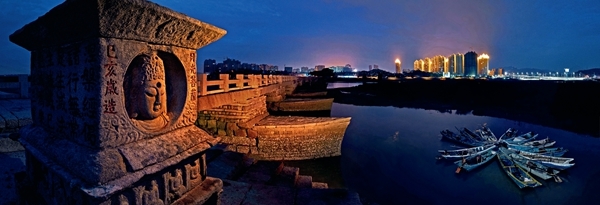Quanzhou, where the Maritime Silk Road starts
 0 Comment(s)
0 Comment(s) Print
Print E-mail China Today, September 12, 2017
E-mail China Today, September 12, 2017
The Maritime Silk Road
Since ancient times, China has engaged in exchanges and trade with other countries of the world. Two thousand years ago, the ancient Chinese developed a trade route that started in China’s southeast coastal area, passing through the Indo-Chinese Peninsula, and then crossing the Indian Ocean and the Red Sea until finally reaching East Africa and Europe.
|
The Qingjing Mosque under the sunset glow. Chen Yingjie |
Until the 8th century, this maritime trade route had mainly been used for the transportation of silk products. Therefore, it is called the Maritime Silk Road. Later, as a result of various reasons including wars, the Maritime Silk Road replaced the overland route and became the main channel for China’s trade and cultural exchanges with foreign countries.
As China’s shipbuilding and navigation techniques improved significantly, such as through the invention of the compass and its application in sailing, China’s commercial ships began voyaging even further. China then developed direct trade links with more than 60 countries and regions, propelling the development of the countries located along the trade route.
During this period, China mainly exported silk products, porcelain, tea, and iron and copper wares. It imported spices, flowers and plants, as well as rare artifacts for royal use. The Maritime Silk Road then came to be known as the maritime porcelain or spice road.
|
The Luoyang Bridge, an ancient architectural masterpiece in Quanzhou. |
Quanzhou’s exchanges with neighboring countries can be traced back to the 6th century. In the 13th century, the city had evolved into China’s busiest port, enjoying the same reputation as Egypt’s port of Alexandria. Quanzhou had trade links and cultural exchanges with nearly 100 countries and regions, including Southeast Asia, Persia, Arabia, and Africa. It exported porcelain, silk, tea and iron, imported spices such as pepper, medicinal materials, and pearls via the maritime trade route.
The Travels of Marco Polo documents the Italian traveler’s 17-year stay in China. Before he left the country he visited Quanzhou, as the last stop of his journey. He was deeply impressed by its burgeoning trade, abundant natural resources and friendly people. He wrote, “There is a port along Citongcheng (the ancient name of Quanzhou), famed for its bustling shipyards. Hordes of businessmen gather there with bountiful products available. Delicate Dehua porcelain is sold at reasonable prices. A Venice silver coin can buy you eight porcelain cups.”
Quanzhou’s shipbuilding technology also surprised Marco Polo. As one of the major shipbuilding bases in the Song and Yuan dynasties. Some of the sturdiest and most advanced ships in the world, known for their stability, seaworthiness, and safety facilities stored in water-tight compartments were built in Quanzhou. The travel book states, “The Khan issued another order to build 14 ships, each one equipped with four masts, able to sail long distances… Among them at least four or five ships can accommodate 250-260 sailors.”
Today, the annual cargo throughput of Quanzhou Port has exceeded 100 million tons, and more than 80 shipping routes are in operation.








Go to Forum >>0 Comment(s)